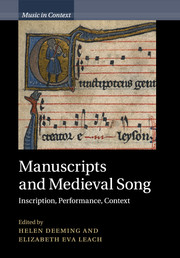Book contents
- Manuscripts and Medieval Song
- Music in Context
- Manuscripts and Medieval Song
- Copyright page
- Contents
- Figures
- Music examples
- Tables
- Contributors
- Book part
- A note on manuscript sigla
- List of manuscripts cited (with links to online surrogates where present)
- Glossary
- Introduction
- 1 New light on the earliest medieval songbook
- 2 The careful cantor and theCarmina Cantabrigiensia
- 3 Across divides: Aquitaine's new song and London, British Library, Additional 36881
- 4 Wine,women, and song? Reconsidering theCarmina Burana
- 5 AnEnglish monastic miscellany: the Reading manuscript ofSumer is icumen in
- 6 Preserving and recycling: functional multiplicity and shifting priorities in the compilation and continued use of London, British Library, Egerton 274
- 7 Miniatures, Minnesänger, music: the Codex Manesse
- 8 Writing,performance,and devotion in the thirteenth-century motet: the ‘La Clayette’ manuscript
- 9 Acourtlycompilation: the Douce Chansonnier
- 10 Machaut's first single-author compilation
- 11 Songs, scattered and gathered
- Bibliography
- Index
- References
Bibliography
Published online by Cambridge University Press: 05 June 2015
- Manuscripts and Medieval Song
- Music in Context
- Manuscripts and Medieval Song
- Copyright page
- Contents
- Figures
- Music examples
- Tables
- Contributors
- Book part
- A note on manuscript sigla
- List of manuscripts cited (with links to online surrogates where present)
- Glossary
- Introduction
- 1 New light on the earliest medieval songbook
- 2 The careful cantor and theCarmina Cantabrigiensia
- 3 Across divides: Aquitaine's new song and London, British Library, Additional 36881
- 4 Wine,women, and song? Reconsidering theCarmina Burana
- 5 AnEnglish monastic miscellany: the Reading manuscript ofSumer is icumen in
- 6 Preserving and recycling: functional multiplicity and shifting priorities in the compilation and continued use of London, British Library, Egerton 274
- 7 Miniatures, Minnesänger, music: the Codex Manesse
- 8 Writing,performance,and devotion in the thirteenth-century motet: the ‘La Clayette’ manuscript
- 9 Acourtlycompilation: the Douce Chansonnier
- 10 Machaut's first single-author compilation
- 11 Songs, scattered and gathered
- Bibliography
- Index
- References
- Type
- Chapter
- Information
- Manuscripts and Medieval SongInscription, Performance, Context, pp. 286 - 312Publisher: Cambridge University PressPrint publication year: 2015

